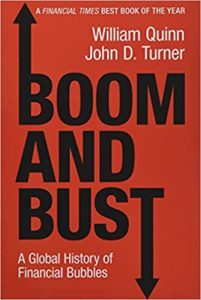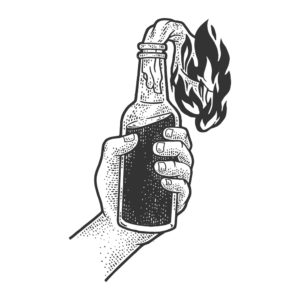
In recent months, my interest in financial bubbles, their causes, and how they form impelled me to buy an exciting book. Specifically, I purchased a copy of Boom and Bust: A Global History of Financial Bubbles by William Quinn and John D. Turner. Although they are not Austrian economists, and they do not cite the Austrian Business Cycle Theory (ABCT), their theories are very similar. At first, I was amazed by its theoretical framework and its way of addressing the concept of speculation bubbles.
What is the Bubble triangle?
Quinn and Turner provided a simple explanation to understand financial crises and named their analytical framework The Bubble Triangle. This triangle is composed of 3 elements: speculation, marketability, and credit/money.
Speculation they define as is the purchase (or sale) of an asset to sell (or repurchase) the asset at a later date with the sole motivation of generating a capital gain.” To Quinn and Turner, speculation can become a problem when novices enter the market when it is getting heated. This relates to the ABCT in that entrepreneurs sometimes may see speculative opportunities due to a mistake (usually, a governmental intervention), and sometimes they lose the capital saved.

Another side of the triangle is marketability. When illiquid assets become relatively more liquid than they used to be, they can be purchased or sold with respective easiness. Of course, when an asset has high levels of liquidity, buyers and sellers can find each other without hassle. According to the authors, this aspect is critical because when an asset bubble forms, it increases its marketability; this has a similar effect on the economy as if someone trying to stop the fire pours gasoline on it. It becomes highly problematic, especially if everyone holds one through an investment or pension fund.
The last and most crucial element is the credit and money available in the economy. In this aspect, Quinn and Turner have Austrian-like elements that are not present in many other accounts. Essentially, they point out that by increasing the credit available in the economy, entrepreneurs and enterprises would invest in deficient projects that otherwise would not have been undertaken.
How does the Bubble Triangle relate to the Austrian Business Cycle Theory?
By incorporating the ABCT model, the increased marketability of malinvested assets, and the entrance of novices into the exchange system in a highly speculative period, we can explain why the bust part of the cycle is so hurtful. A good analogy is that sometimes the economy may spark a fire; if everything goes well and there are firefighters near, the fire remains under control. If, on the contrary, each person has a gallon of gasoline near them, the fire can spread more quickly and cause more damage.
For instance, look at the malinvested mortgage loans in the Great Recession. Many agencies back in 2005 graded many of these securities as AAA. After the crisis hit, 83% of these AAA securities were downgraded because firms misinterpreted the real risk of these assets. In a non-liquid market, the failures of loans wouldn’t have the same impact as if these loans were made more liquid so anyone could purchase them. That is to say, when high-liquid assets result from an error induced by a decrease in interest rates, every economic agent seems to be affected in one way or another. This issue could explain the harshness of the bust stage and why it takes so long for the economy to recover.
A greater focus must be put on the mismanagement of the central banks. Anyone who has read I, Pencil by Leonard Reed would understand how complex the various stages of production are, and how division of labor and voluntary cooperation are so impossible to coordinate through central planning. If economists have agreed that central planning has failed to coordinate the production of goods and services, how can we expect that the manipulations of interest rates could bring any good? It is more challenging to coordinate intertemporal production than immediate future production.
Overconfidence is not enough to explain why this generalization of bad investment happens not just among novice investors but also through investment firms. Yes, novices may commit mistakes when they are trying to speculate. But this part of the arbitrage process of the market is looking to clear and balance profit rates between different investment demands.
Conclusion
There is still much to work to do on the theory of business cycles. Whether the explanation comes from one school of thought or the other is irrelevant to each individual. Even so, the introduction of different financial concepts to the Austrian analysis might help us understand the extent of the boom and the suffering of the bust.
Carlos Martinez is a Cuban American undergraduate student attending Rockford University. He is pursuing a BS in financial economics. Currently, he holds an Associate of Arts degree in economics and data analysis.


READER COMMENTS
Thomas Lee Hutcheson
Aug 27 2022 at 4:08pm
Might have some relevance in an economy with no central bank, or one with some strange targeting rule, but otherwise does not seem very plausible.
Matthias
Sep 5 2022 at 5:43am
Novices in the market shouldn’t make much of a difference?
If there are more noise traders, it is easier for the people with a clue to make money, isn’t it?
Unskilled novices who are eager to speculate subsidise the experts, don’t they?
Comments are closed.